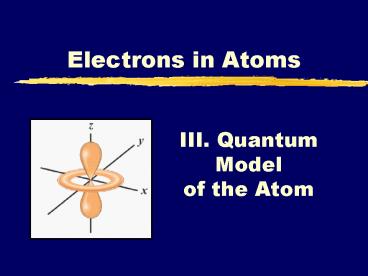III' Quantum Model of the Atom - PowerPoint PPT Presentation
1 / 20
Title:
III' Quantum Model of the Atom
Description:
III. Quantum Model. of the Atom. Electrons in Atoms. A. Electrons ... Orbital ('electron cloud') Region in space where there is 90% probability of finding an e ... – PowerPoint PPT presentation
Number of Views:153
Avg rating:3.0/5.0
Title: III' Quantum Model of the Atom
1
III. Quantum Model of the Atom
- Electrons in Atoms
2
A. Electrons as Waves
- Louis de Broglie (1924)
- If radiation energy can behave as a stream of
- particles could matter show properties of a
wave? - Characteristic ? of an e- or other particle
depends on - ? h
- mv (momentum)
- This equation predicts that all moving objects
have - wavelike behavior
3
A. Electrons as Waves
QUANTIZED WAVELENGTHS
4
A. Electrons as Waves
EVIDENCE DIFFRACTION PATTERNS
5
B. Quantum Mechanics
- Heisenberg Uncertainty Principle
- Impossible to know both the velocity and position
of an electron at the same time
6
B. Quantum Mechanics
- Orbital (electron cloud)
- Region in space where there is 90 probability of
finding an e-
7
B. Quantum Mechanics
- Orbitals
- s p
- d
8
B. Quantum Mechanics
- Orbitals
- f
9
C. Quantum Numbers
- Four Quantum Numbers
- Specify the address of each electron in an atom
10
C. Quantum Numbers
- 1. Principal Quantum Number ( n )
- Energy level
- Size of the orbital
- n2 of orbitals in the energy level
11
C. Quantum Numbers
- 2. Angular Momentum Quantum ( l )
- Energy sublevel
- Shape of the orbital
12
C. Quantum Numbers
- n of sublevels per level
- n2 of orbitals per level
- Sublevel sets 1 s, 3 p, 5 d, 7 f
13
C. Quantum Numbers
14
C. Quantum Numbers
- 3. Magnetic Quantum Number ( ml )
- Orientation of orbital
- Specifies the exact orbitalwithin each sublevel
15
C. Quantum Numbers
px
py
pz
16
C. Quantum Numbers
- Orbitals combine to form a spherical shape.
17
C. Quantum Numbers
- 4. Spin Quantum Number ( ms )
- Electron spin ? ½ or -½
- An orbital can hold 2 electrons that spin in
opposite directions.
18
C. Quantum Numbers
- Pauli Exclusion Principle
- No two electrons in an atom can have the same 4
quantum numbers. - Each e- has a unique address
1. Principal ? 2. Ang. Mom. ? 3. Magnetic
? 4. Spin ?
energy level sublevel (s,p,d,f) orbital electron
19
C. Quantum Numbers
20
Feeling overwhelmed?
Read Section 7.5!





























